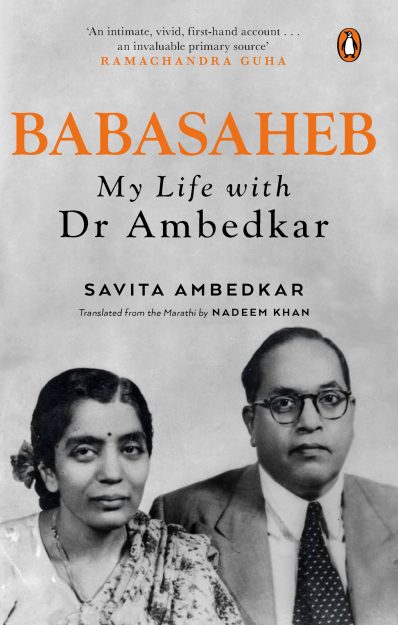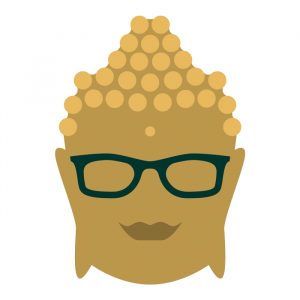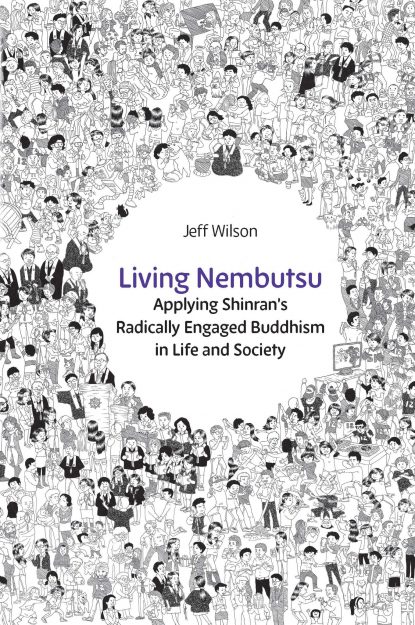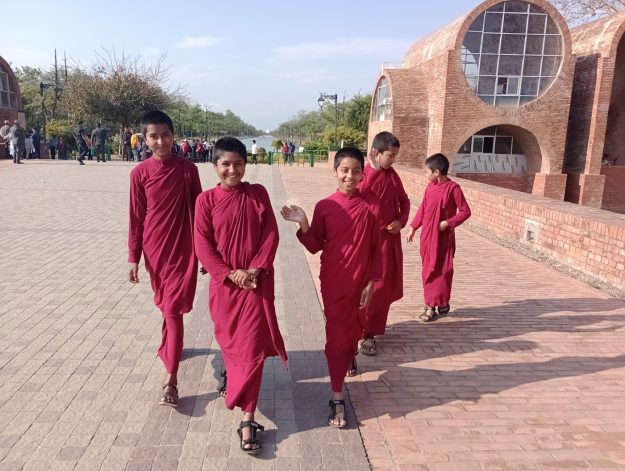![bell hooks spiritual vision SOCIAL]()
When the author, radical feminist, and Black Buddhist Christian bell hooks died in late 2021, she was widely celebrated for just about everything in the mainstream press except for her spirituality.
But hooks’s connection to religion is present throughout her entire breadth of work, which includes thirty books across a variety of genres as well as countless articles on feminism (and how it is for everyone), popular culture, education, recognizing the human rights of children, and more. This missing component of spiritual recognition was part of the motivation for bell hooks’ Spiritual Vision: Buddhist, Christian, and Feminist by Nadra Nittle, a journalist and education reporter at The 19th, an independent news outlet that covers gender, politics, and policy.
The book was published by Fortress Press in November 2023. Tricycle recently spoke with Nittle about the book, hooks’s legacy in spiritual circles and beyond, and as well as book recommendations for Buddhist readers interested in learning more about hooks’s life and work.
You’re the author of several books, including Toni Morrison’s Spiritual Vision: Faith, Folktales, and Feminism in Her Life and Literature. Can you tell me how this book came to be? Sure. I had written a book about Toni Morrison for Fortress Press, which is a Lutheran publisher. My books are for people who are not necessarily religious, but interested in how a figure they might not associate with a spiritual tradition approached spirituality in their work or personal lives. They serve as an introduction to people who have never read these authors before; some people read them as a companion piece to read with their books.
The publisher wanted me to write another book and had suggested some men. But I thought bell hooks would be a good figure because she was a Buddhist Christian, and many people didn’t necessarily know that, even though she discussed it. It didn’t come up in a lot of her obituaries. Spirituality was foundational to her work. And she died shortly after the Toni Morrison book came out.
You write about bell hooks visiting your school in the 1990s, when you were a teenager. Can you tell us your impressions of hooks and what has stayed with you? I wish I remembered it better; this was such a long time ago. I had not read any of her books, though I knew she was an important person and an important figure. I remember being pretty intimidated.
I remember the speech she gave, saying that she didn’t think her father had loved her, how she had been saying it for years, and her mother finally agreed with her. She was challenging the idea that all that Black families, in particular low-income families, needed was a man in their home and all of their problems would go away. You heard a lot about welfare queen moms in the 1990s; you still hear about them today, but especially in the nineties. President Bill Clinton had passed welfare reform, and single mothers, especially Black single mothers, were vilified. So for hooks to come out and say, “No, we don’t just need men in the home, they have to be loving men who are not going to perpetuate patriarchy,” was pretty radical. And this is something she discusses in Bone Black: Memories of Girlhood, and other pieces.
She sat with us at lunch, and I sat close to her. She was discussing movies—this part got cut from the book. There was a movie called Sankofa, about a Black American model who gets more in touch with her African roots, and it also discusses issues around enslavement. I remember one of my classmates getting into an argument with her. My classmate loved the movie, and hooks thought it had problems—obviously, she was very critical of popular culture. But she wasn’t like, “Oh, you’re just a little teenager, you don’t know what you’re talking about.” She was respectfully arguing with him and treated him as someone capable of having an argument.
Yes, and one other thing about her visit, which I write about in the book. I didn’t witness this, but bell hooks told one of my friends that she was beautiful, and should consider not straightening her hair and wearing it natural. And she stopped straightening her hair, and she told everyone that bell hooks told her that she was beautiful. I’m not in touch with this person anymore, but hooks really left a positive impact on her.
I enjoyed learning more about hooks’s cultural criticism in your book. Unfortunately, I only came to hooks later in life, so she’s always been a Buddhist Christian radical feminist to me. And to learn about her interview with Lil’ Kim and her willingness to speak out against Hillary Clinton, even Beyoncé—especially Beyoncé. [In a 2014 panel discussion at the New School called Are You Still A Slave: Liberating the Black Female Body, hooks said Beyoncé was “antifeminist” and a “terrorist” to young Black girls.] To go up against these figures and take a lot of criticism makes her fearless to me. You refer in the book to hooks’s “Buddhist Christian ethic.” Can you expand on what that means? That’s in reference to what she took from both Buddhism and Christianity: the idea that you weren’t spiritual or religious for the sake of being spiritual or religious, you did so for the benefit of other people, to engage in social action. There was love at the root of it, the love of one’s self and the love of other people. She used the late author and psychiatrist M. Scott Peck’s definition of love, which he said was one’s commitment to one’s own spiritual growth or someone else’s spiritual growth.
You brought up Beyoncé, so when she was criticizing Beyoncé, or criticizing white supremacist capitalist patriarchy, she believed that she was doing so in love, in the tradition of Martin Luther King, Jr. and Thich Nhat Hanh and other figures that she was influenced by, like Thomas Merton—people who had social action and liberation right at the heart of their spiritual tradition.
In a 1992 interview with Tricycle’s founding editor, Helen Tworkov, hooks spoke about her hesitance in meeting Thich Nhat Hanh, whose social activism inspired her Buddhist practice. “As long as I keep a distance from that thread, I can keep him—and I can critique myself on this—as a kind of perfect teacher.” Did she ever meet Thich Nhat Hanh? Yes, she was afraid of meeting him because she didn’t want to be disappointed by him or have [him be] a big letdown. I write in the book about how when hooks first met Hanh, she was still so angry at a past partner who was abusive to her, and she blurted out the words “I’m so angry.” And Hanh told her to “compost” her anger, to turn it into something, for lack of a better term, positive, something that can be used for good instead of her just stewing in anger. And it seems that he handled her anger in a very wise way that she appreciated.
What about hooks’s upbringing in the Christian church? It seems that she was drawn to social action and outreach from a young age. She was born in 1952 and grew up in Kentucky. She went to predominantly Black churches, where she found people who supported her speaking abilities by reading scriptures; she found people who encouraged her to use her “god voice.” That was in contrast to her home life, where she was more of a misfit and the family scapegoat. She had a difficult relationship with her father; it seemed they butted heads from an early age. She was considered strange or weird by her family members and told she was crazy, even for things like her reading habits. Her mother bought her books, and her family was supportive of her being a good student, but they were still worried if she was going to be a proper young woman who was attractive, found a mate, and was a homemaker—all of those things that she didn’t want to be.
Her family life really contrasted with her church experience, which was a place of refuge for her. There was an elderly woman, a deacon in the church, who took an interest in hooks and supported her and was loving toward her; she’s the one who told her she had a “god voice.” And both of her maternal grandparents had unique experiences and ideas about spirituality. Her maternal grandmother was not a churchgoing person; she saw the church as being superficial and people caring more about what you wore and who you knew. She was spiritual, but more so when it came to nature—growing things, being self-sufficient, and living off the land. So that was a model for hooks. And her grandfather believed every object had a soul and that she needed to know the stories of all the things around her. He was considered by others to be a strange guy. He was also a pacifist—he never went to war, he refused to fight. hooks believed he was the one family member who truly loved her.
And this was one of the reasons [why] she was opposed to the traditional, nuclear family, because she believed that it takes a village to raise a child. And if you did have a village, you were more likely to find people who rooted for you and nurtured you. hooks felt that her father was not loving; he was physically abusive to her, to her mother, and at times to her siblings. At one point, this started to affect hooks’s relationship with her mother, because her mother would sometimes act abusively toward her to get into her husband’s good graces. And I haven’t gotten into child liberation theology yet…
We did see a bit of that earlier when you recounted hooks telling your school friend that she was beautiful and to not straighten her hair and engaging in a respectful debate with your other classmate. And with her mother being abusive, that shows that it doesn’t have to be men acting patriarchal, it’s the system, right? Yes. I think the most radical part of bell hooks is her belief that women can enforce or perpetuate patriarchy. Often in popular culture, when we’re talking about the #MeToo movement, or sexism and misogyny in general, it’s framed as women not perpetuating any of these things. And she very much believed women are capable of perpetuating patriarchy and teaching their sons to be patriarchal. She also said women need to interrogate their ideas about women and gender.
You write that one of the things that drew hooks to Buddhism was her confronting this image of a white Jesus at her Black church. Later in her life, she goes on a pilgrimage to Spain to see the Black Madonna at Montserrat as a way to reclaim the divine feminine for Black women. How did that trip impact her view on spirituality? As a child, hooks went to a church where they had a huge image of a white Jesus holding a globe, and at the bottom of the globe were all the people of color. She discussed how this image really had an impact on her brother who struggled to be a Christian, to be confronted with this image of a white Jesus, that he didn’t feel represented by, every Sunday. It doesn’t sound like she took that as hard as her brother did, but she longed for representations of divine feminine deities portrayed in all different colors, shapes, and sizes.
One of the reasons she became interested in Buddhism was [because] she saw Buddha portrayed in various colors, shapes, and sizes. One of her first encounters with Buddhism was through Buddhist nuns during the time she was a student at Stanford University. She met them, took an interest [in their message], and decided to pursue Buddhism. In terms of the divine feminine and Christianity, she was interested in the Virgin Mary and, specifically, the Black Madonna. She hadn’t grown up hearing about or seeing a Black Madonna, but eventually, she made a pilgrimage to Montserrat, Spain, to view this statue.
It’s also important to mention that the Catholic Church has recently made an effort to start portraying Jesus, Mary, and other figures in different races and ethnicities, so that people feel represented.
All About Love: New Visions, hooks’s book that was published in 2000, made a resurgence during the pandemic and even made the New York Times’ bestseller list for the first time, twenty years after its original publication. Why do you think it resonated so much with readers? In the US, we now have more single-headed households than partnered or married households. During the pandemic, especially during lockdown, people were isolated, and it made them think about their connections to other people, maybe in a way they hadn’t before. And people who were partnered or married had to deal with being around their partners for sustained periods, whereas before they were going out or going to work and didn’t have to see their partner or children as much. The pandemic forced some people to engage with their partners and children in ways they hadn’t prior to the pandemic. It makes sense people were interested in a book like All About Love during that time. Quotes from the book were being shared on TikTok and other forms of social media, so I think it was a perfect mix of social media, the pandemic, and younger generations being exposed to the book for the first time. And there are some influential people, like the filmmaker Sofia Coppola and the model Emily Ratajkowski, who began to cite the book as important in their lives and development.
I also discussed that we can see from dating sites like Match.com that people are looking for more substantial relationships, not just a pretty or handsome face. All About Love is a go-to book for people interested in going beyond the butterflies and rush of feelings at the beginning of a courtship; this book is really about a deeper connection. And she was really clear that she didn’t want to just focus on romantic relationships. A lot of people who like All About Love cited the fact that she writes friendship should be equal to any other relationship, and that friendship will be different (than romantic love) but should not be devalued. And that was a lesson hooks wished she had learned before entering into an abusive relationship where she found herself isolated.
There’s a quote attributed to the Buddha about friendship being the whole of the spiritual path. And the other thing is the epidemic of loneliness that we sometimes overlook. And she was discussing that more than twenty years ago. Now, there’s more attention to the fact that it’s not just elderly people who suffer from loneliness; there are a lot of young people who are lonely and looking for connection. And that may be a reason why [so many] young people [are now appreciating] the book.
Toward the end of All About Love, hooks writes that the book is a guide about love, but also death. And if we treat each interaction with someone as if it were our last, that would change how we interact with others; it would allow us to live more consciously. To me, that’s a very Buddhist sentiment. Are there any Christian parallels between living consciously or staying connected to loved ones who have died? As a text, the Bible focuses on the importance of your ancestors. But in contemporary Christianity, in the US, I think that ancestors are not focused on in the same way. hooks was interested in how Black American and West African spirituality mixed with mainstream Christianity, and how during enslavement, Black people had to hide their African spiritual traditions but found a way to still have yard shrines and altars, even if it was just having rocks or things placed in a certain kind of way. Or the pictures in their house arranged in a way that transcended enslavement and white supremacy in an attempt to separate Black people from all that.
And hooks believed in the power of naming ancestors too. That’s the whole reason she chose a pseudonym after her great-grandmother Bell Blair Hooks. I tried to honor hooks by naming her grandparents in the book.
Lineage is so important in Buddhism—who your teacher is and lineages that can be traced back to the time of the Buddha. It’s interesting to see the parallels with other religions. Can you recommend a few books for Buddhist readers who have never read hooks or who would like to revisit her more spiritual works? All About Love is one of the books where she most engages spirituality, be it Buddhism or Christianity. Her memoir, Bone Black, will allow you to see where she came from and why spirituality was important for her. [Bone Black also provides some framework for] the lessons and understanding [she received from] her Kentucky ancestors, who were not at all familiar with Buddhism [but who] paved her way to becoming a Buddhist; whether it was her grandfather being a pacifist and telling her that everything has a soul or her grandmother using quilting as a form of meditation, losing herself in the process and coming back to herself. And then, Sisters of the Yam: Black Women and Self-Recovery. She’s urging Black women to not just have a patriarchal, fundamental approach to Christianity, but to expand our options, whether that’s through Buddhism, traditional African religion, Hinduism, or something else.
I wanted to close with something hooks wrote in All About Love: “Sometimes, we invoke the dead by allowing wisdom they have shared to guide our present actions.” Since you have spent so much time with hooks’s writing, what do you think she would make of the world right now, especially with multiple conflicts going on? Her grandfather, who was one of her teachers, was a pacifist. Hanh and King were pacifists. So I think she would be horrified.
About ten years ago, she was one of many writers and scholars who signed a letter in support of Palestine. I imagine she would be heartbroken by what’s happening there. And she cautioned people to be wary of the media and the messages in the media. She talked about the importance of making sure you have access to a wide range of information and aren’t just turning on the TV and absorbing whatever messages [come your way, which often] perpetuate what she coined as “imperialist white supremacist capitalist patriarchy.” I think she would urge people to take in the news with caution and advocate for peace and liberation.
⧫
This interview has been edited and adapted for length and clarity.
The post The Spiritual Lives of bell hooks appeared first on Tricycle: The Buddhist Review.































 by
by 










